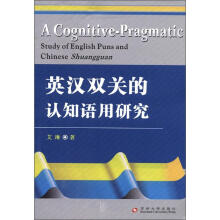英汉双关的认知语用研究

Chapter 1 Introduction
1.1 A general description of English puns and Chineseshuangguan
2.2 Significance of studying English puns and Chineseshuangguan
1.3 Objectives of the present study
1 4 Research methodology and theoretical framework
1.5 Organization of the book
Chapter 2 Survey of the Literature
2.1 Introduction
2.2 Multidimensional approaches to the study of English puns
2.2.1 A rhetorical approach
2.2.2 A semantic approach
2.2.3 A relevance-theoretic approach
2.3 Major approaches to the study of Chineseshuangguan
2.3.1 A rhetorical approach
2.3.2 A semantic approach
2.3.3 A pragmatic approach
2.3.4 A comparative approach
2.4 Summary
Chapter 3 A Prototype-based Approach to English Puns
and Chinese Shuangguan
3.1 Introduction
3.2 Prototype theory as the theoretical foundation
3.3 English puns: Prototypical and non-prototypical uses
3.4 Chinese shuangguan : Prototypical and non-prototypical uses
3.5 Towards a unified definition of pun in both English and Chinese
3.6 Summary
Chapter 4 Formal and Semantic Analyses of Puns in
Chinese and English Talk Shows
4.1 Introduction
4.2 The data
4.2.1 The rationale for the choice of data from talk shows
4.2.2 Characteristics of the face-to-face oral communication in talk
shows
4.2.3 Description of the data
4.3 A formal analysis of puns: Four prominent modes of punning
4.3.1 An overview of previous studies on modes of punning
4.3.2 Four prominent modes of punning used in talk shows
4.4 A semantic analysis of puns: Transparent, semi-transparent and
opaque puns
4.5 Summary
Chapter 5 A Unified Account of Pun Processing
5.1 Introduction
5.2 Relevance theonj
5.3 The graded salience hypothesis
5.4 Context
5.5 Interpretation of transparent puns
5.5.1 Linguistic and pragmatic features of transparent puns
5.5.2 Processing of transparent puns
5.6 Interpretation of semitransparent puns
5.6.1 Linguistic and pragmatic features of semitransparent puns
5.6.2 Processing of semitransparent puns
5.7 Interpretation of opaque puns
5.7.2 Linguistic and pragmatic features of opaque puns
5.7.2 Processing of opaque puns
5.8 Effects of different contextual cues
5.9 Summary
Chapter 6 Conclusion
6.1 Major findings of the present study
6.2 Theoretical and practical implications
6.3 Limitations of the study and suggestions for future research
Appendix
References
1.1 A general description of English puns and Chineseshuangguan
2.2 Significance of studying English puns and Chineseshuangguan
1.3 Objectives of the present study
1 4 Research methodology and theoretical framework
1.5 Organization of the book
Chapter 2 Survey of the Literature
2.1 Introduction
2.2 Multidimensional approaches to the study of English puns
2.2.1 A rhetorical approach
2.2.2 A semantic approach
2.2.3 A relevance-theoretic approach
2.3 Major approaches to the study of Chineseshuangguan
2.3.1 A rhetorical approach
2.3.2 A semantic approach
2.3.3 A pragmatic approach
2.3.4 A comparative approach
2.4 Summary
Chapter 3 A Prototype-based Approach to English Puns
and Chinese Shuangguan
3.1 Introduction
3.2 Prototype theory as the theoretical foundation
3.3 English puns: Prototypical and non-prototypical uses
3.4 Chinese shuangguan : Prototypical and non-prototypical uses
3.5 Towards a unified definition of pun in both English and Chinese
3.6 Summary
Chapter 4 Formal and Semantic Analyses of Puns in
Chinese and English Talk Shows
4.1 Introduction
4.2 The data
4.2.1 The rationale for the choice of data from talk shows
4.2.2 Characteristics of the face-to-face oral communication in talk
shows
4.2.3 Description of the data
4.3 A formal analysis of puns: Four prominent modes of punning
4.3.1 An overview of previous studies on modes of punning
4.3.2 Four prominent modes of punning used in talk shows
4.4 A semantic analysis of puns: Transparent, semi-transparent and
opaque puns
4.5 Summary
Chapter 5 A Unified Account of Pun Processing
5.1 Introduction
5.2 Relevance theonj
5.3 The graded salience hypothesis
5.4 Context
5.5 Interpretation of transparent puns
5.5.1 Linguistic and pragmatic features of transparent puns
5.5.2 Processing of transparent puns
5.6 Interpretation of semitransparent puns
5.6.1 Linguistic and pragmatic features of semitransparent puns
5.6.2 Processing of semitransparent puns
5.7 Interpretation of opaque puns
5.7.2 Linguistic and pragmatic features of opaque puns
5.7.2 Processing of opaque puns
5.8 Effects of different contextual cues
5.9 Summary
Chapter 6 Conclusion
6.1 Major findings of the present study
6.2 Theoretical and practical implications
6.3 Limitations of the study and suggestions for future research
Appendix
References
艾琳,女,江苏无锡人,现为江南大学外国语学院副教授。2004年和2007年分别获得上海外国语大学“英语语言文学”硕士学位和“外国语言学及应用语言学”博士学位。研究兴趣包括:对比语言学、认知语言学、语用学,旁涉翻译学和跨文化交际。工作至今,在国内各类期刊发表学术论文十余篇,参编教材一部。
语用学和认知语言学是语言学中的两个重要分支。《英汉双关的认知语用研究》从语用和认知的视角,对英汉双关的异同提出了独到的见解,对英汉双关的认知理解模式做了有益的探索。《英汉双关的认知语用研究》资料翔实,例证丰富,可读性强,对语言学的研究者和修辞学的爱好者都具有较高的参考价值。
比价列表价格走势
公众号、微信群
 缺书网
缺书网微信公众号
 扫码进群
扫码进群实时获取购书优惠







